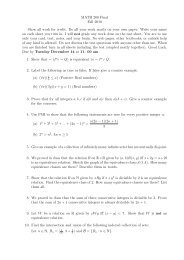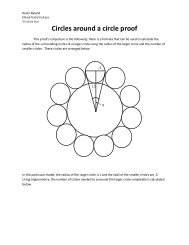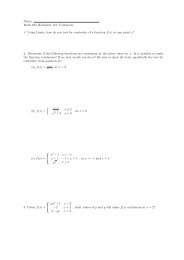Plant Growth in Aquaponic System through Comparison of Different ...
Plant Growth in Aquaponic System through Comparison of Different ...
Plant Growth in Aquaponic System through Comparison of Different ...
You also want an ePaper? Increase the reach of your titles
YUMPU automatically turns print PDFs into web optimized ePapers that Google loves.
There are many different medias <strong>in</strong> which to grow plants, and each has advantages and<br />
disadvantages. The medias used <strong>in</strong> this experiment were gravel, soil, and coconut fiber. Gravel<br />
has a large surface area for bacteria to grow and perform nitrification. Also, the composition the<br />
gravel itself can provide some nutrients for plants as the water weathers the rock, for example<br />
calcium can be released as the gravel reacts with acid produced dur<strong>in</strong>g nitrification (Rakocy et<br />
al., 2006). A disadvantage is that the gravel reta<strong>in</strong>s very little water. Soil has the ability to supply<br />
the plants with enough water without becom<strong>in</strong>g overly saturated. Because soil is composed <strong>of</strong><br />
smaller gra<strong>in</strong> sizes compared to gravel, it is able to reta<strong>in</strong> some water while the excess dra<strong>in</strong>s out.<br />
There are also pore spaces that provide the plant roots with air (McCauley et al., 2005). Soil<br />
naturally conta<strong>in</strong>s nutrients, but does not always conta<strong>in</strong> enough for healthy plant growth and it<br />
can be depleted <strong>of</strong> nutrients as the plant grows. Coconut fiber is made from the husk <strong>of</strong> a<br />
coconut. It is highly absorbent material but it does not conta<strong>in</strong> abundant nutrients. The different<br />
medias provide surface area for bacteria to grow and perform nitrification, and capture solids<br />
before they reach the plant roots (Rakocy et al., 2006). A good medium for plant growth creates<br />
a nutrient pool around the plant roots and provides adequate air space for respiration (Sikawa,<br />
2010).<br />
There are a total <strong>of</strong> 18 essential nutrients for maximum plant growth. The three<br />
macronutrients are carbon, oxygen, and hydrogen, which are supplied by the water and carbon<br />
dioxide gas. Other macronutrients provided by the nutrient filled water <strong>in</strong>clude nitrogen,<br />
potassium, calcium, magnesium, phosphorus, and sulfur. The rema<strong>in</strong><strong>in</strong>g nutrients are<br />
micronutrients. A balance <strong>of</strong> all these nutrients provides for optimal plant growth (Rakocy et al.,<br />
2006).






